Procedure for Developing and Approving APT Common Proposals ...
Procedure for Developing and Approving APT Common Proposals ...
Procedure for Developing and Approving APT Common Proposals ...
You also want an ePaper? Increase the reach of your titles
YUMPU automatically turns print PDFs into web optimized ePapers that Google loves.
PROCEDURE FOR DEVELOPING AND APPROVING <strong>APT</strong> COMMON<br />
PROPOSALS FOR ITU WORLD CONFERENCE ON<br />
INTERNATIONAL TELECOMMUNICATIONS<br />
1. Introduction<br />
1.1 The objective of the <strong>APT</strong> preparatory Group <strong>for</strong> the ITU World Conference on<br />
International Telecommunications (WCIT) is to develop proposals that have a greater<br />
chance of success through the support of a number of <strong>APT</strong> Members.<br />
1.2 These proposals can take the <strong>for</strong>m of an <strong>APT</strong> <strong>Common</strong> Proposal (ACP) of the Asia-<br />
Pacific region.<br />
1.3 An ACP is a multi-country proposal to which the approved Working <strong>Procedure</strong>s <strong>for</strong><br />
the <strong>APT</strong> have been applied during its development. The definition of <strong>and</strong> approval<br />
process <strong>for</strong> an ACP, as defined by this document, are specified <strong>for</strong> <strong>APT</strong> proposals to<br />
WCIT.<br />
1.4 These proposals are developed in a two-stage process:<br />
• The first stage is the development preliminary proposals by <strong>APT</strong> Members, on<br />
the basis of input <strong>and</strong> discussion by Members <strong>for</strong> inclusion in the Output<br />
Documents of the <strong>APT</strong> Preparatory Group meeting <strong>for</strong> WCIT;<br />
• The second stage is where each <strong>APT</strong> Member is invited to approve the proposal<br />
by adding its name to the document that is submitted to the ITU <strong>for</strong> consideration<br />
by an ITU World Conference on International Telecommunications.<br />
1.5 It is not the intention of the <strong>APT</strong> to bind Members to particular positions in relation to<br />
international conferences, <strong>and</strong> there<strong>for</strong>e, any ACP must clearly identify those <strong>APT</strong><br />
Members who have chosen to sign up to it.<br />
2 Process <strong>for</strong> Development <strong>and</strong> Approval of an ACP<br />
Stage One: Development of a Preliminary <strong>APT</strong> <strong>Common</strong> Proposal (PACP)<br />
2.1 <strong>Proposals</strong> are developed by the Correspondence Groups (CGs) of the <strong>APT</strong><br />
Preparatory Group <strong>for</strong> WCIT. The working method is by discussion through e-mail<br />
reflectors <strong>and</strong> at the CG meetings during the <strong>APT</strong> preparatory meetings <strong>for</strong> WCIT,<br />
prior to being presented to the Plenary sessions of the preparatory meetings.<br />
2.2 If there is consensus at the Plenary, a proposal becomes a PACP.<br />
2.3 If there is a difference of opinion at the Plenary <strong>and</strong> further discussion cannot produce<br />
a consensus then, the Chairman can, as a last resort, <strong>for</strong>ward the proposal as a PACP,<br />
provided that;<br />
a) the proposal is supported by at least one quarter (25%) of the <strong>APT</strong> Members<br />
present at the Plenary meeting <strong>and</strong>;<br />
b) the proposal is not opposed by a number of Members present at the Plenary greater<br />
than the number of Members at the Plenary who support it.
Stage Two : Development of an <strong>APT</strong> <strong>Common</strong> Proposal (ACP)<br />
2.4 On confirmation of a proposal as a PACP, all <strong>APT</strong> Members will be asked to consider<br />
inclusion of their country name as a signatory to that proposal. A PACP becomes an<br />
ACP provided that;<br />
a) the proposal is supported by at least one quarter (25%) of all the <strong>APT</strong> Members<br />
<strong>and</strong>;<br />
b) the proposal is not opposed by more than 50% of the number of Members who<br />
support it.<br />
3 <strong>APT</strong> Positions<br />
3.1 The <strong>APT</strong> Preparatory Groups <strong>for</strong> WCIT may also consider development of an <strong>APT</strong><br />
Position on:<br />
<br />
<br />
a contribution submitted to WCIT by another country or region; or<br />
an issue that is being, or will be, discussed at the WCIT.<br />
3.2 The purpose of developing an <strong>APT</strong> Position is to assist <strong>APT</strong> Members in negotiations<br />
or discussions at the WCIT on a particular issue or contribution. It will be an internal<br />
document <strong>for</strong> use by members of <strong>APT</strong>.<br />
3.3 The <strong>APT</strong> Position would be approved by consensus in the Plenary of the <strong>APT</strong><br />
Preparatory Group Meeting.<br />
3.4 An <strong>APT</strong> Position may also be the basis <strong>for</strong> an <strong>APT</strong> <strong>Common</strong> Proposal developed <strong>and</strong><br />
submitted during the WCIT.<br />
4 <strong>APT</strong> Coordination Meeting at the WCIT<br />
For the purposes of the development <strong>and</strong> approval of <strong>APT</strong> <strong>Common</strong> <strong>Proposals</strong> <strong>and</strong> <strong>APT</strong><br />
Positions, the <strong>APT</strong> Coordination Meetings at the WCIT are considered as Plenary of the <strong>APT</strong><br />
Correspondence Group meetings.<br />
_____________________


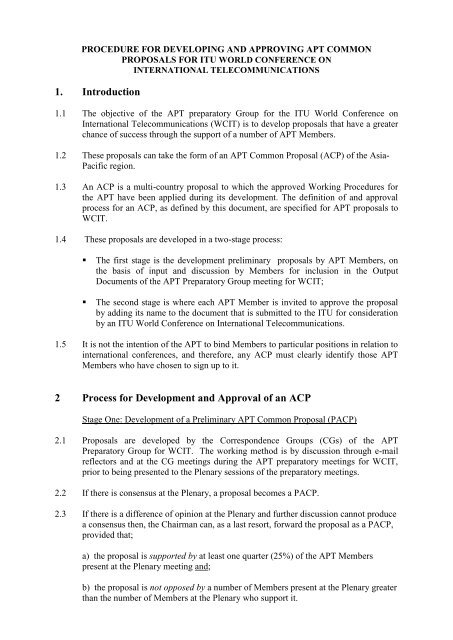
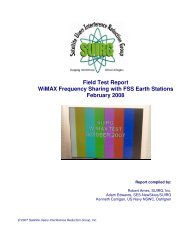
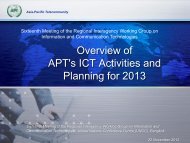
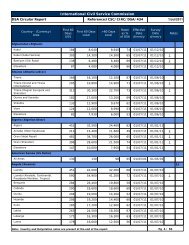
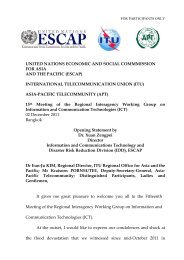
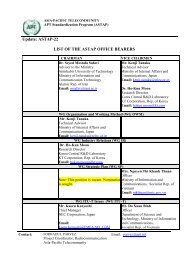
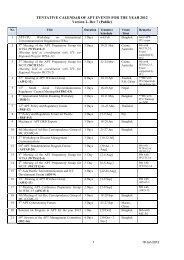

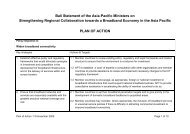
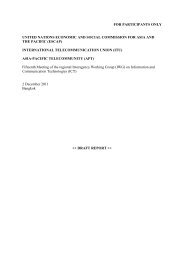
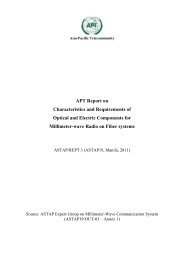
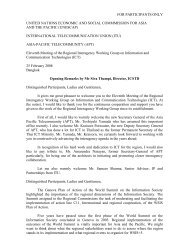
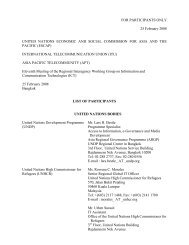

![Annex 1 RESOLUTION 805 [COM6/7] (WRC-07) Agenda for the ...](https://img.yumpu.com/39340961/1/184x260/annex-1-resolution-805-com6-7-wrc-07-agenda-for-the-.jpg?quality=85)